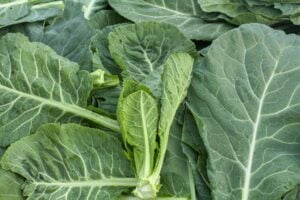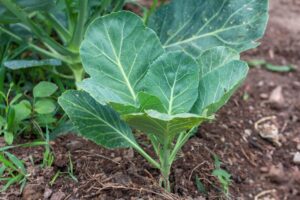Collards Intercropping
Try companion planting if you’re looking for ideas and methods to improve your garden harvest this year. With the help of these companion plants for collards green, you may improve garden success and reduce insect and disease damage.
Home gardeners and farmers alike have used companion planting for decades. The idea is that although some plants work well together and even aid in the defense against disease and pests, others have a detrimental effect on both growth and the prevention of disease.
Tips for Companion Planting
Select plants that thrive in comparable environments and take into account their preferred soil pH and light needs when companion planting. Take basil and tomatoes as an example; they grow nicely together since they require similar maintenance. To maximize your garden’s produce and space, be careful to take each plant’s rate of growth into account as well. For instance, since you may harvest them before the squash and melons take over the space, radishes and baby lettuce grow swiftly and thrive next to them.

Companion planting also enables you to learn which plants to keep apart. To prevent the spread of a disease, it is best to keep plants that are sensitive to the same diseases separate, such as potatoes and tomatoes. Other plants’ growth may also be hampered by some plants.
Beans are susceptible to chemical substances from the lily family, including shallots, chives, garlic, and onions (referred to as root exudates). Even after the onions are long gone, if beans are planted in a spot where you formerly had onions, the root exudates in the soil may still have an impact on them.
Companion plants for collards
Collard greens and other members of the Brassicaceae family share a lot of preferences. Members of the cabbage family, such as collards, might benefit greatly from the use of aromatic plants and herbs to ward off the white cabbage butterfly. The top companion plants for collards greens are listed below:
- Celery
- Onions
- Potatoes
- Dill
- Chamomile
- Sage
- Peppermint
- Rosemary
- Hyssop
- Thyme
- Wormwood
- Southernwood
Read About: Companion plants for spinach
How to grow collards
The technique of growing collard greens is rather simple, and they usually do well if given enough sunlight, water, and insect management. The best companion plants for collards will aid in pest management, but you might also need to use insecticidal soap to further ward off whiteflies.
You can grow collard greens from the seed inside, transplant them into your garden, or plant them directly into the ground. Plant your seeds 2-4 weeks before the latest date of the local frost if you’re direct-sowing. Three to four weeks prior to the latest day of frost, you can transplant plants into your garden (after hardening off). If your temperature is predicted to drop below 20°F, make careful to cover them. However, I would err on the side of safety and cover them if the temperature dropped below 32°F.
Grow collards from seed
If you’ve decided to grow collards from seed, you can either plant them outdoors directly 2-4 weeks prior to the anticipated last frost date OR you can start them indoors 4-6 weeks prior to the last frost and transplant them once they have their first set of true leaves and have sufficiently hardened off.
Place 2-4 seeds 1/2′′ deep in moist, fertile soil to start a garden from scratch. Keep your plants adequately moist, but watch out not to overwater them. Plant the seeds in rows that are 36 inches apart, spacing the seeds 18 to 24 inches apart. Plants should be thinned to the strongest ones in each group.
Harvesting of collards
The outer leaves can be harvested after the plants reach a foot tall. If you are not going to harvest the full head of collard greens, you should harvest it from the bottom up. This will leave the lower stem naked and give the plant a tree-like appearance. In cool conditions, the heart of the leaf will continue to generate new leaves.
Collard leaves should be picked while they are young, dark green, and under a foot long. Older leaves are sometimes tough and less flavorful. Move along the stem beginning with the bottom leaves. The plant will be fragile and vulnerable to injury when frozen, but the leaves can still be gathered then. The flavor is enhanced by frost.
This is all about companion plants for collards and how we can grow them in our home gardens.

[…] Best Companion Plants For Collards Intercropping […]